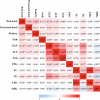Association of meat consumption with NAFLD risk and liver-related biochemical indexes in older Chinese: a cross-sectional study
- PMID: 34001005
- PMCID: PMC8127290
- DOI: 10.1186/s12876-021-01688-7
Association of meat consumption with NAFLD risk and liver-related biochemical indexes in older Chinese: a cross-sectional study
Abstract
Background: Non-alcohol fatty liver disease (NAFLD) is the most common liver disease and an unhealthy lifestyle can lead to an increased risk of NAFLD. The present study aims to evaluate the association of meat consumption with NAFLD risk and liver-related biochemical indexes in middle-aged and elderly Chinese.
Methods: A cross-sectional study was conducted in individuals who were 45 years or older and underwent a physical examination from April 2015 to August 2017 in Southeast China. To evaluate associations between meat intake and NAFLD risk, inverse probability of treatment weighting and subgroup analyses were performed with logistic regressions. Spearman's rank correlation was carried out to examine the relationship between meat consumptions and liver-related biochemical indexes.
Results: High consumptions of red meat (28.44-49.74 and > 71.00 g/day) (ORadjusted = 1.948; P < 0.001; ORadjusted = 1.714; P = 0.002) was positively associated with NAFLD risk on inverse probability of treatment weighting analysis, adjusting for smoking, tea intake, weekly hours of physical activity and presence of hypertension, dyslipidemia and diabetes. Exposure-response relationship analysis presented that red meat intake was positively associated with NAFLD risk. Significant associations of red meat intakes with serum levels of γ-glutamyl transferase, alanine transaminase, aspartate aminotransferase, total triglyceride and high-density lipoprotein cholesterol were found (rs = 0.176; P < 0.001; rs = 0.128; P < 0.001; rs = 0.060; P = 0.016; rs = 0.085; P = 0.001; rs = - 0.074; P = 0.003).
Conclusions: These findings suggest that the reduction of meat consumption may decrease NAFLD risk and should warrant further investigations.
Keywords: Liver-related biochemical indexes; Meat consumption; Non-alcoholic fatty liver disease.
Conflict of interest statement
All the authors declare that there are no financial or other relationships that might lead to a conflict of interest of the present article.
Figures



Similar articles
-
Association of fish and meat consumption with non-alcoholic fatty liver disease: Guangzhou Biobank Cohort Study.BMC Public Health. 2023 Dec 6;23(1):2433. doi: 10.1186/s12889-023-17398-6. BMC Public Health. 2023. PMID: 38057730 Free PMC article.
-
High red and processed meat consumption is associated with non-alcoholic fatty liver disease and insulin resistance.J Hepatol. 2018 Jun;68(6):1239-1246. doi: 10.1016/j.jhep.2018.01.015. Epub 2018 Mar 20. J Hepatol. 2018. PMID: 29571924
-
Association between Monocyte to High-Density Lipoprotein Cholesterol Ratio and Nonalcoholic Fatty Liver Disease: A Cross-Sectional Study.Mediators Inflamm. 2021 Dec 7;2021:6642246. doi: 10.1155/2021/6642246. eCollection 2021. Mediators Inflamm. 2021. PMID: 34916874 Free PMC article.
-
Gender impacts on the correlations between nonalcoholic fatty liver disease and hypertension in a Chinese population aged 45-60 y.Clin Exp Hypertens. 2016;38(7):639-643. doi: 10.1080/10641963.2016.1182181. Epub 2016 Sep 28. Clin Exp Hypertens. 2016. PMID: 27680771
-
Association between processed and unprocessed red meat consumption and risk of nonalcoholic fatty liver disease: A systematic review and dose-response meta-analysis.J Glob Health. 2024 Apr 26;14:04060. doi: 10.7189/jogh.14.04060. J Glob Health. 2024. PMID: 38665062 Free PMC article.
Cited by
-
Association of fish and meat consumption with non-alcoholic fatty liver disease: Guangzhou Biobank Cohort Study.BMC Public Health. 2023 Dec 6;23(1):2433. doi: 10.1186/s12889-023-17398-6. BMC Public Health. 2023. PMID: 38057730 Free PMC article.
-
Prevalence of Non-alcoholic Fatty Liver Disease in Iran: A Systematic Review and Meta-analysis.J Clin Exp Hepatol. 2024 Jan-Feb;14(1):101209. doi: 10.1016/j.jceh.2023.06.009. Epub 2023 Jun 29. J Clin Exp Hepatol. 2024. PMID: 38076354 Free PMC article. Review.
-
Association Between Serum Uric Acid Levels and Metabolic-Associated Fatty Liver Disease in Southeast China: A Cross-Sectional Study.Diabetes Metab Syndr Obes. 2024 Sep 7;17:3343-3354. doi: 10.2147/DMSO.S476045. eCollection 2024. Diabetes Metab Syndr Obes. 2024. PMID: 39268333 Free PMC article.
-
High red meat consumption among PNPLA3 polymorphism carriers is associated with NAFLD in a multi-center cross-sectional study.Eur J Clin Nutr. 2024 May;78(5):442-448. doi: 10.1038/s41430-024-01416-w. Epub 2024 Feb 26. Eur J Clin Nutr. 2024. PMID: 38403728
-
Dietary Approaches for Management of Non-Alcoholic Fatty Liver Disease: A Clinician's Guide.Curr Gastroenterol Rep. 2021 Oct 15;23(12):21. doi: 10.1007/s11894-021-00827-0. Curr Gastroenterol Rep. 2021. PMID: 34654976 Review.
References
MeSH terms
Grants and funding
LinkOut - more resources
Full Text Sources
Other Literature Sources
Medical
Miscellaneous

